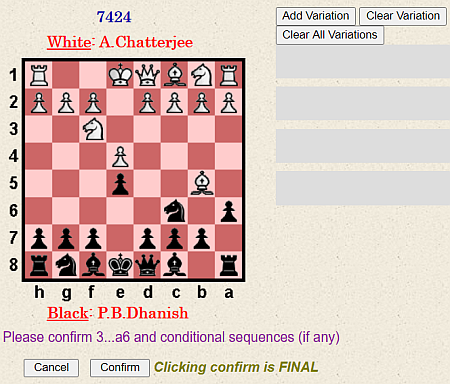Conditional moves
 |
| Fig 1 |
 |
| Fig 2 |
 |
| Fig 3 |
What are Conditional Moves?
Normally you make a move when it is your turn. Then you have to wait for the opponent's reply before you can move again. If you can anticipate what the opponent is likely to play and set some variations in advance, you can save time. For example, along with your opening move 1.e4. you may add some conditional sequences like:
(a) 1...e5 2.Nf3 Nc6 3.Bb5 a6 4.Ba4
(b) 1...c5 2.Nf3 d6 3.d4 cxd4 4.Nxd4 Nf6 5.Nc3
The opponent will not know that you have entered these variations. But if now he plays 1...e5, the server will automatically play the move 2.Nf3 from your side and it will be the opponent's turn again. The thinking time for your move 2.Nf3 will be zero days. Now if he plays 2...Nc6 then again 3.Bb5 will be played automatically from your side. If at any point your opponent deviates from your proposed move, or when there are no more conditional moves, it will be your turn again.
Usefulness of Conditional Moves
Conditional moves can speed up the game in the opening stages. In later stages, conditional sequences can help you to come out of time trouble. You can set a variation when you make a capture and the opponent's next move is likely to be a recapture. Sometimes there is a long forced sequence that you can set. You can even create simple branch in a variation as explained below. Conditional moves are completely hidden from the opponent, so suggesting conditional moves will not reveal your strategy.
How to set Conditional Moves
In Fig 1, Black is making the move 3...a6 (see Make move). One can add variations before clicking Confirm. First click Add Variation. The first grey variation box will be highlighted. You will now be able to move the pieces of both players sequentially to prepare a variation. If you change your mind or if you make a mistake, click Clear Variation or Clear All Variations.
In Fig 2, Black has added one variation:
4.Ba4 Nf6 5.O-O Be7
One can add upto 4 variations. Each variation can go to a depth of 8-ply (16 half-moves). While adding a variation, you must end with your own move (otherwise the system will alert you).
Branches in a conditional sequence
Sometimes you want to set a branch to cover more than one possibility inside a variation. To create a branch, make another variation repeating the common moves of the previous variation.In Fig 3 Black has created 3 variations which is equivalent to one variation with two branches:
4.Ba4 Nf6 5.O-O
[5.d3 d6]
[5.Qe2 b5 6.Bb3 Be7]
5...Be7
The server limits you to 4 variations each no more than 8-ply. Conditional moves more complicated than that cannot be created.
Submit move along with variations
When all the variations have been created and checked, click the Confirm button. After that it will not be possible to withdraw the move and the variations.Opponent's reply
After the opponent replies, the moves pending in the variation remain. In the above example, if White replies 4.Ba4, the server will automatically move 4...Nf6 and it will still be White's move and the remaining part of the variations remain intact.
Conditional moves set by both players
Conditional moves set by a player cannot be seen by the opponent. Therefore the situation arises where the opponent may create a continuation which goes partly or completely along a line already created. In such a case the server will take the game forward as far as it can go taking into account the variations created by both players.
Mate or Stalemate inside a variation
The server will allow you to create conditional sequences that end in mate or stalemate. When the opponent replies and if the game proceeds to that point, the game will end.7-men endgame tablebase situation reached inside a variation
If it is an engine-forbidden game, there is no tablebase adjudication. If it is an engine-allowed game the software will not prevent you from and only 7-men are left during the course of a variation, the software will not prevent you from proceeding with the variation